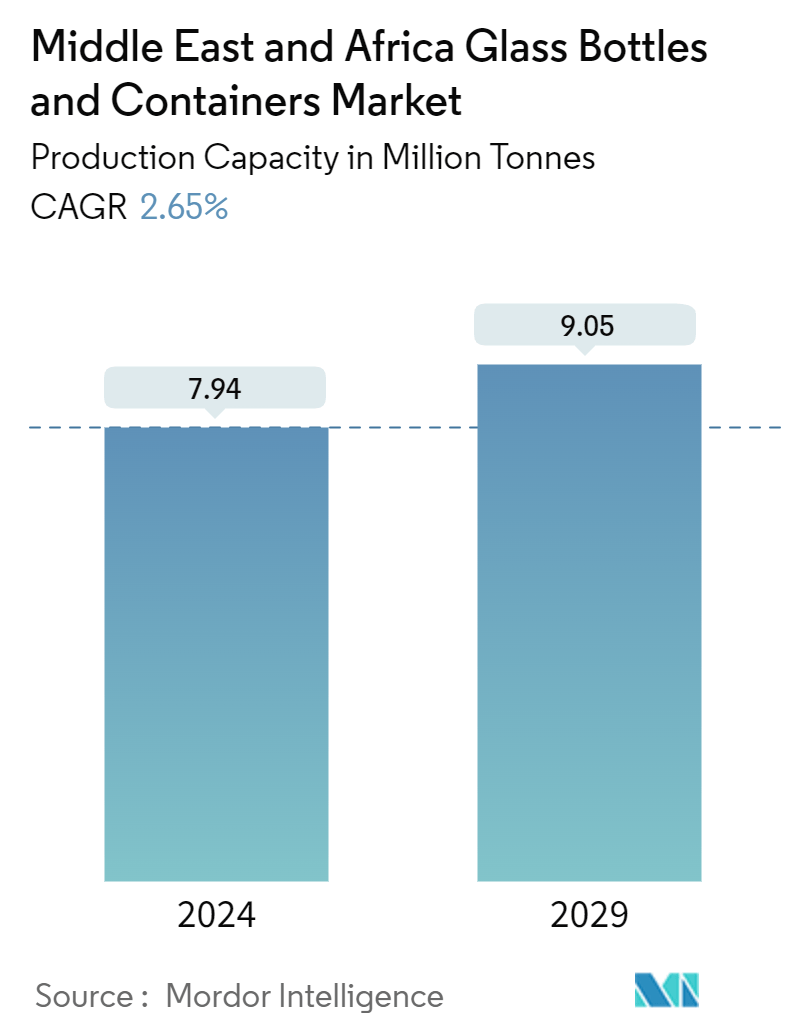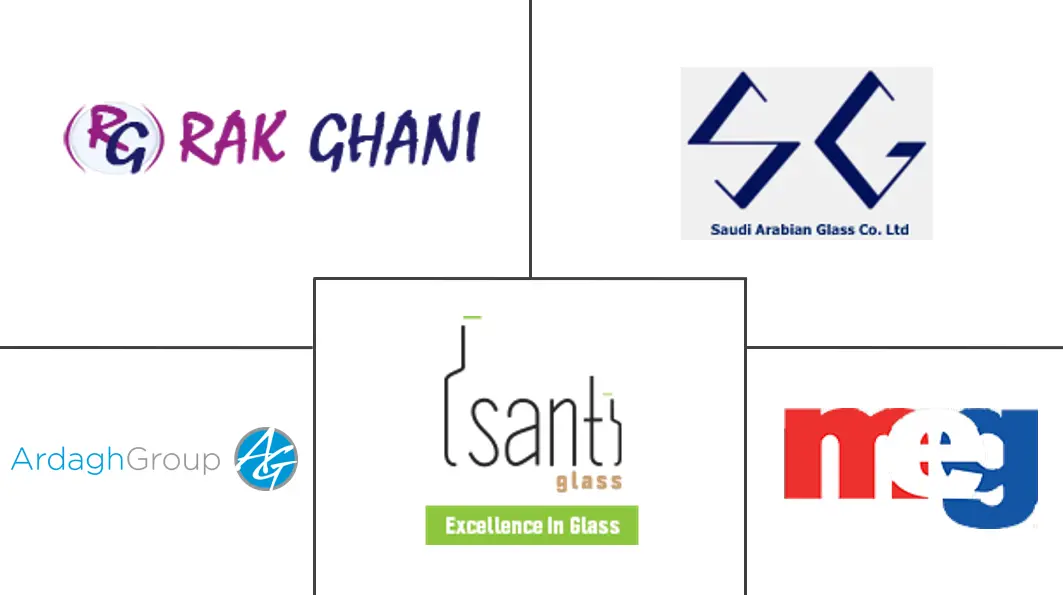Market Size of Middle East & Africa Glass Bottles And Containers Industry

| Study Period | 2019 - 2029 |
| Market Volume (2024) | 7.94 Million tonnes |
| Market Volume (2029) | 9.05 Million tonnes |
| CAGR (2024 - 2029) | 2.65 % |
| Fastest Growing Market | Africa |
| Largest Market | Middle East |
| Market Concentration | Medium |
Major Players
*Disclaimer: Major Players sorted in no particular order |
Middle East and Africa Glass Bottles Market Analysis
The Middle East & Africa Glass Bottles And Containers Market size in terms of production capacity is expected to grow from 7.94 Million tonnes in 2024 to 9.05 Million tonnes by 2029, at a CAGR of 2.65% during the forecast period (2024-2029).
Glass containers offer transparency, enabling consumers to see the product while safeguarding its sensory and nutritional qualities. This attribute has solidified their status as the region's preferred choice for packaging beverages and pharmaceuticals.
- The demand for glass containers surges in the Middle East and Africa, driven by increasing beverage consumption in Saudi Arabia and South Africa. This uptick in beverage consumption is witnessed owing to a booming tourism industry, rising disposable incomes, and evolving consumer preferences.
- Heightened awareness of environmental issues and sustainability among consumers has spurred a preference for glass packaging over plastic. This shift is mainly because glass is perceived as a more environmentally friendly option, thanks to its recyclability.
- Countries in the region are witnessing a thriving food and beverage industry fueled by strong economic growth and heightened domestic consumption. Highlighting this growth, the US Department of Agriculture (USDA) reports that the United Arab Emirates is home to more than 2,000 food and beverage manufacturing companies, collectively raking in an impressive USD 7.63 billion in annual revenue.
- As consumers increasingly demand safer and healthier packaging, glass packaging is witnessing growth across various categories. Innovative technologies, such as embossing, shaping, and artistic finishes, enhance the appeal of glass packaging among end-users. Additionally, the post-pandemic resurgence of the market can be attributed to the rising demand for eco-friendly products and heightened interest from the food and beverage sector.
- Accordiung to a study by Glass Online, a publisher for the glass industry, Africa, currently home to about 16% of the global population and projected to reach 20% by 2030, presents a significant opportunity for glass producers. The continent boasts untapped markets where consumers face limited choices. South Africa, the continent's second-largest economy, is a leading nation in container glass production. With a production capacity surpassing 1 million tons annually, South Africa has become one of Africa's advanced container glass producers.
- However, the market faces challenges. The rising preference for plastic packaging, lauded for its cost-effectiveness and lighter weight than glass, poses a significant hurdle. Furthermore, glass' fragility, in contrast to plastic, results in higher freight costs and risks of breakage during transit, potentially hindering market growth in the Middle East and Africa.
Middle East and Africa Glass Bottles Industry Segmentation
Glass Containers refer to clean bottles and jars made from glass. The scope excludes windows and other non-container glass products. Container glass is used in the alcoholic and non-alcoholic beverage industries due to its ability to maintain chemical inertness, sterility, and non-permeability. Glass packaging is valued for its unique properties, including its transparency, inertness, and ability to preserve the quality and integrity of its contents.
Middle East and Africa Container Glass Market are Segmented by End-User Industry ((Beverages (Alcoholic Beverages (Wines and Spirits, Beer and Cider, and Other Alcoholic Beverages) and Non-Alcoholic Beverages (Carbonated Drinks, Juices, Water, Dairy-Based, Other Non-Alcoholic Beverages)), Food, Cosmetics, Pharmaceutical, and Other End-User Industries) and By Country (United Arab Emirates, Saudi Arabia, Egypt, South Africa, Nigeria, Kuwait, and Rest of the Middle East and Africa). The Market Sizes and Forecasts are Provided in Terms of Volume (Tonnes) for all the Above Segments.
| By End-user Industry | |||||||||||||||
| |||||||||||||||
| Food | |||||||||||||||
| Cosmetics | |||||||||||||||
| Pharmaceutical (Excluding Vials and Ampoules) | |||||||||||||||
| Other End-user Industries |
| By Country | |
| United Arab Emirates | |
| Saudi Arabia | |
| Egypt | |
| South Africa | |
| Nigeria | |
| Kuwait |
Middle East & Africa Glass Bottles And Containers Market Size Summary
The Middle East and Africa glass bottles and containers market is experiencing a notable expansion, driven by increasing demand across various sectors such as beverages, food, cosmetics, and pharmaceuticals. The rise in beer consumption, particularly in Africa, is a significant factor contributing to the market's growth, as glass bottles are the preferred packaging choice due to their premium look, chemical inertness, and recyclability. The region's focus on sustainable packaging solutions has led to substantial investments in new facilities and capacity expansions by key players like Ardagh Glass Packaging Africa. This trend is further supported by the growing personal disposable income, which is boosting sales in premium glass packaging. The market is characterized by a competitive landscape with numerous domestic and international players adopting strategies like partnerships and expansions to enhance their product offerings and geographic reach.
In the pharmaceutical sector, the demand for glass packaging is driven by the need for durable and safe drug delivery solutions, with significant investments being made to meet stringent regulatory standards. The healthcare industry's expansion, particularly in Saudi Arabia, is supported by improved healthcare infrastructure and increased healthcare expenditure, which are expected to drive the demand for pharmaceutical glass packaging. Additionally, the market is witnessing a shift towards localized glass packaging for non-alcoholic beverages, with companies like Coca-Cola committing to sustainable packaging goals. The ongoing investments and strategic partnerships in the region are anticipated to bolster market growth, offering new opportunities and supporting economic recovery plans.
Middle East & Africa Glass Bottles And Containers Market Size - Table of Contents
-
1. MARKET INSIGHTS
-
1.1 Market Overview
-
1.2 Import Export Trade Data of Container Glass
-
1.3 PESTLE Analysis
-
1.4 Industry Standards and Regulations for Container Glass Use for Packaging
-
1.5 Sustainability Trends for Packaging
-
1.6 Container Glass Furnace Capacity and Location In Middle East & Africa
-
-
2. MARKET SEGMENTATION
-
2.1 By End-user Industry
-
2.1.1 Beverages
-
2.1.1.1 Alcoholic Beverages (Qualitative Analysis to be Provided)
-
2.1.1.1.1 Wins and Spirits
-
2.1.1.1.2 Beer and Cider
-
2.1.1.1.3 Other Alcoholic-Beverages
-
-
2.1.1.2 Non-alcoholic Beverages (Qualitative Analysis to be Provided)
-
2.1.1.2.1 Carbonated Drinks
-
2.1.1.2.2 Juices
-
2.1.1.2.3 Water
-
2.1.1.2.4 Dairy-Based
-
2.1.1.2.5 Flavored Drinks
-
2.1.1.2.6 Other Non-Alcoholic Drinks
-
-
-
2.1.2 Food
-
2.1.3 Cosmetics
-
2.1.4 Pharmaceutical (Excluding Vials and Ampoules)
-
2.1.5 Other End-user Industries
-
-
2.2 By Country
-
2.2.1 United Arab Emirates
-
2.2.2 Saudi Arabia
-
2.2.3 Egypt
-
2.2.4 South Africa
-
2.2.5 Nigeria
-
2.2.6 Kuwait
-
-
Middle East & Africa Glass Bottles And Containers Market Size FAQs
How big is the Middle East & Africa Glass Bottles And Containers Market?
The Middle East & Africa Glass Bottles And Containers Market size is expected to reach 7.94 million tonnes in 2024 and grow at a CAGR of 2.65% to reach 9.05 million tonnes by 2029.
What is the current Middle East & Africa Glass Bottles And Containers Market size?
In 2024, the Middle East & Africa Glass Bottles And Containers Market size is expected to reach 7.94 million tonnes.

